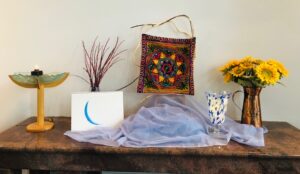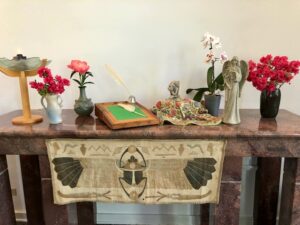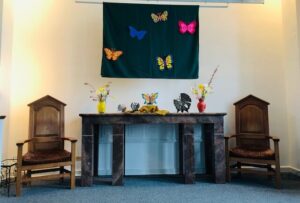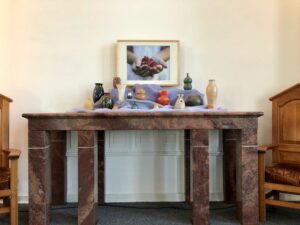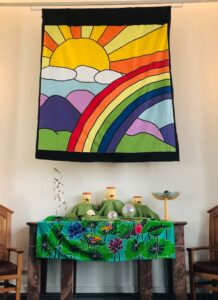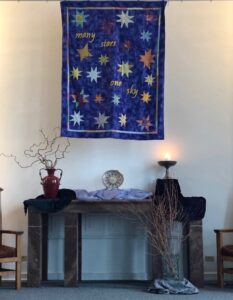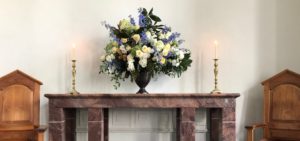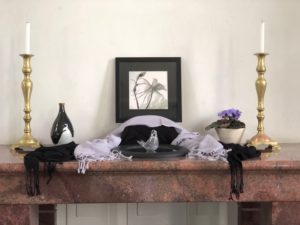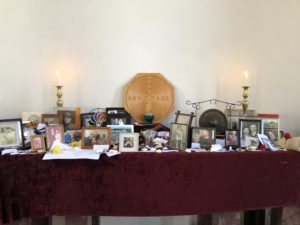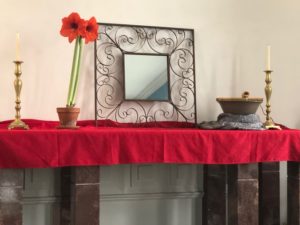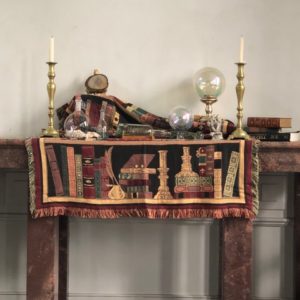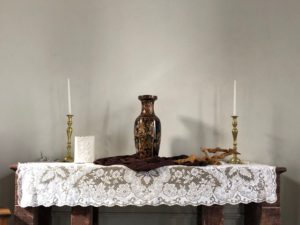Opening Words:
The abbot of a provincial monastery was in something of a tizzy, because the abbot of his school’s main temple was coming for a visit, and he wanted everything to be just perfect. He had set his students to polishing every bit of wood, and brass, and gold, and to seek out every single dust bunny. He, himself, attended to the grounds.
An old monk, a recognized Zen master who had retired to this monastery watched as the young abbot spent several hours raking leaves from all of the walking trails. The abbot wanted the woods to exude quiet, and peace, and … well … perfection. He imagined walking these clear, unobstructed paths with his honored guest, just as he strove to lead the monks under his care over the clear, unobstructed paths of the dharma.
As I said, the old monk stood watching the abbot at his labors the whole time. When he was finished, the abbot came to the monk, and with pride in his accomplishment the young man asked the old man what he thought. “Well … ,” the old monk said, “I have to say, you’ve certainly worked very, very hard at this, and it’s almost right.
The abbot replied, somewhat anxiously, “Please, tell me what I have to do to make it perfect.” “I’d rather show you,” the old master said. He took the rake, and spent the next hour putting the leaves back on the path. “There,” he said when he was done. “Now it’s perfect.”
He gave the rake to the startled abbot, and walked away without another word.
Sermon:
One hour a day. One day a week. One week a year.
One hour a day. One day a week. One week a year.
I want you to hold on to that formula. We’ll come back to it later. (I’ll come back to that story about the monks and the leaves in a bit, too.)
Most Sundays I note that the heart of our sanctuary service is not the sermon, or the music, (or the offering!), it’s what we call the time of “Going Deeper.” Our lives can be so full, and so hectic, I say (as if it would be news to any of us). Every religious tradition I know anything about exhorts us to seek, to find, or to create spaces and places in our lives where we are not overcome by the cacophony of life; where our hearts and our minds can find respite; where our souls can be silent and calm.
In the book of 1 Kings in the Hebrews Scriptures the story is told of the prophet Elijah who asks to see G_d. After all manner of images pass him by – a strong wind that can destroy a mountain, an earthquake, an all-consuming fire – after all of these things pass him by, Elijah finally recognizes his G_d in what is usually translated as, “a still, small voice.” (It is alternately rendered, “a gentle whisper,” or, my favorite, “the voice of quiet stillness.”)
We have, hopefully, each of us had our own experiences of such sacred silence, times where the world grew quiet … and so did we. Spiritual practices such as meditation and contemplative prayer can be understood to be, at the very least, about learning to create and cultivate such peace in a world, in our lives, which are most often anything but.
We need such times. We need such places. We need such experiences. Because just as we have been learning how vitally important sleep is to our bodily and mental health, so too is such peace vitally important to our spiritual health.
The Unitarian Transcendentalist Ralph Waldo Emerson (who, a colleague once described as, “wash[ing] out of the ministry early”) had more than a little to say about sacred space. In his essay Nature, St. Ralph described an experience he had in nature, that has been often quoted (although here I’m going to read a little more than is usually used):
Crossing a bare common, in snow puddles, at twilight, under a clouded sky, without having in my thoughts any occurrence of special good fortune, I have enjoyed a perfect exhilaration. I am glad to the brink of fear. In the woods, too, a [person casts off [their] years, as the snake [its] slough, and at what period soever of life is always a child. In the woods, is perpetual youth. Within these plantations of God, a decorum and sanctity reign, a perennial festival is dressed, and the guest sees not how [they] should tire of them in a thousand ears. In the woods, we return to reason and faith. There I feel that nothing can befall me in life, — no disgrace, no calamity, (leaving me my eyes), which nature cannot repair. Standing on the bare ground – my head bathed by the blithe air, and uplifted into infinite space – all mean egotism vanishes. I become a transparent eye-ball. I am nothing. I see all. The currents of the Universal Being circulate through me; I am part or particle of God.
The Austrian poet René Karl Wilhelm Johann Josef Maria Rilke, better and more simply known as Rainer Maria Rilke had similar thoughts about the ocean:
“When anxious, uneasy and bad thoughts come, I go to the sea, and the sea drowns them out with its great wide sounds, cleanses me with its noise, and imposes a rhythm upon everything in me that is bewildered and confused.”
How many of us have had such experiences? How many of us – in the woods, by the ocean, at the bank of a river, on a trail, in our gardens – how many of us have found this kind of sacred space and felt its healing balm (at least some of the times)? I have always loved the power of an incoming storm, when the temperature drops and the winds pick up, and the sky changes color and, almost, texture. (I’ve read that the Persian poet Khalil Gibran did too – going up to the roof of his apartment in New York City whenever a really powerful storm was coming.) Like Emerson, I experience “a perfect exhilaration […] am glad to the brink of fear,” and find my worries and woes dropping away.
All of this is why our time of “Going Deeper” is the hub, the heart of what we do here week after week. This time we set aside is, for some of us, the only time when we can slow down long enough to have even a taste of this kind of stillness. And for some of us – no doubt for many of us – this place is as important as this time. We come here, to this sanctuary, as, if you will, to an in-town forest or ocean. We come here to seek a stillness, to find a stillness, so that that stillness can carry us through the rest of our week.
The Unitarian Universalist pastor and preacher Rev. Phillip Hewett described this seeking in words that are often used as Opening Words in UU congregations (it’s #440 in the back of our hymnals):
“From the fragmented world of our everyday lives we gather together in search of wholeness. By many cares and preoccupations, by diverse and selfish aims are we separated from one another and divided within ourselves.”
Another story. (And I haven’t forgotten that earlier story about the monks and the leaves, nor the formula with which I began – one hour a day; one day a week; one week a year. I hope you haven’t yet either, and if you did I’ve just reminded you.)
I’ve mentioned before that when I was in my 20s I had the wonderful opportunity to spend two months in Japan working with the Kanjiyama Mime troupe. This was in the midst of the twenty or so year period in which I followed the Zen Buddhist path, so although my work in Japan was centered mostly in and around Tokyo, I simply had to make a side trip to Kyoto, which was the Imperial capital of Japan for over 1,000 years. It’s also been called “the city of temples,” because of its 1,600 Buddhist temples and 400 Shinto shrines.
I visited several Buddhist temples while I was there, particularly those with the justly famed gardens of stone and raked sand. And I have to say, when I walked onto the temple grounds – and this was true of all of the temples I visited – I was overwhelmed with a sense of peace. It was nearly palpable, and I felt myself infused with it. Just being there quieted my mind and stilled my soul. It was powerful, and an experience I hope I never forget (no matter how much else I may come to forget).
And this pervasive and palpable peace was perhaps nowhere more present than in the zendo. These beautiful, spare spaces seemed filled with the energy generated by the monks who meditated there day after day, week after week, years upon years, over centuries and centuries. It seemed to me that these halls had been infused by the peace of its monks, just as it held the fragrance of all of the incense that had been burned there.
At one of the temples the monk who was walking me around brought me outside the back of its zendo. The meditation hall had been built at the base of a cliff, and there was a place where a small waterfall had carved a channel in the rock. Ice cold water from a mountain stream above still fell, as it had for centuries. At the base of this channel there was a somewhat circular, somewhat flat rock … about the size of a meditation cushion, actually. And the monk told me that the most advanced students would sometimes leave the zendo during the time of meditation, that they would get off their cushions and come out here. They would leave the peace and stillness of the zendo and come out here to continue their zazen practice— here, on that rock, under that icy shower. He invited me to touch it, and even the brief period it poured over my hand was quite literally bone chilling. And there were monks who choose to practice here under this freezing flow, rather than in the warmth and peace of the meditation hall.
Since I posted the Black Lives Matter sign on the wall behind this pulpit, I have heard from some of you who’ve said that it disrupted, and for some even destroyed, the feeling of peace you had in this hall, and which you sought still. For some it’s the “garish” colors, discordant with soft blue of the wall. Some felt it to be an intrusion of the outer world into this inner space, an imposition of the political – and the divisively political at that – into this place of peace. “I used to look up at the altar throughout the service” someone said to me, “and it would allow me to let everything go.” This person continued, “Now I can’t. Whenever I look toward the altar I see that sign, and I can no longer get away from anything … even for just this one hour.”
I would note that this isn’t everyone’s experience. I have also heard from some of you who find the presence of this sign a powerfully positive thing. Many – not all, but many – people of color, and perhaps especially those who are new to the congregation, who are checking it out, have said that seeing that sign not only outside of our building, but inside it as well, has made them feel truly welcomed and safe in a predominantly white faith community … for the first time. “You see me,” they’ve said. “And you care enough about me to say that explicitly, here, in this sacred space, even though it must cause some of you discomfort to do so.” As Unitarian Universalists – particularly as Unitarian Universalists committed to the vision of true Beloved Community, that is truly multigenerational and multicultural and committed to the dismantling of racism and the systems and structures of oppression of all kinds – as Unitarian Universalists we know that having our needs met is not the ultimate measure of our success. Rather, it’s to be a people who know that what matters most is our collective needs, the needs of our whole community, and that means sometimes setting aside my own needs for the sake of someone else’s. This is one of my reasons for keeping the sign where it is – while some of us are discomforted by its presence, others (and not just people of color, but some of us who identify as white, as well) are more comfortable because it’s there.
I’ve also said, over the years, that if those of us who identify (or are identified as) white are really committed to the overthrow of the deeply and fundamentally racist culture that is U.S. culture, if we’re really committed to this work, then we are going to have to change. We are going to have to be uncomfortable, because it is uncomfortable work to let of what we’ve known, and learn to see the world through new eyes. Yesterday, at the Families Belong Together rally downtown, we were reminded by one of the speakers that as outraged as we are by the separation of immigrant families today, it’s been happening in our country to brown and black families since the founding of the nation – African families, native families, the families of anyone deemed to be “Other” have had their families split up as a deterrent .. a deterrent to even thinking about fighting back against their oppression and their oppressors. This makes a lot of white folk really uncomfortable, as we want to believe that this kind of behavior is an aberration, and it’s tremendously disconcerting and disorienting to discover that it’s actually been a part of the fabric of our culture from the beginning.
I’ve preached this need for those of us who identify as white to “get comfortable with being uncomfortable,” to lean into the pain that brings with it, and to realize that our assertion, our assumption, that we can and should be comfortable is a piece of privilege not shared equally. Black and brown people – like women, those who identify as part of LGBTQI communities, Muslims, and everyone who’s been historically, and still are, marginalized – have had to get comfortable with being uncomfortable because that’s a part of their daily experience. I’ve preached this, and this message has been greeted with applause and praise for my “courage” and willingness to “say what has to be said.” The presence of this sign is one way to remind us of these truths.
My two Buddhist stories are another way of understanding what the presence of this sign, in this place, is all about. It is easy to find peace in peaceful places. It is easy to be still when there is stillness all around. It is easy, with apologies to Kipling, for us to “keep our heads when all about us are keeping theirs.” But try meditating under a shower of ice cold mountain water. Try finding a clear path when it’s obscured by leaves. Try looking at the altar and letting everything go when out of the corner of your eye you see a reminder of the pain and the struggle in our world.
I can imagine that some of you are experiencing these reflections as being more than a little … defensive. And I can imagine that some of you are experiencing them as being dismissive … of your concerns, of your real disheartening discomfort, of your own felt needs.
I hope that I’m not being defensive; I’m hoping that I’ve been offering an explanation of why, in this regard, I am doing what I’m doing. Agree or disagree, I hope I’m helping you to better understand.
I am aware, though, that I have often come across as dismissive. I acknowledge that some of you here – and no doubt many who are not – have felt dismissed, especially this year and especially since the end of February when that anonymous racist note and attack was directed at our Director of Administration and Finance, Christina Rivera, and her family. And while I do recognize and acknowledge that for some here that has been the impact of some of what I’ve said and done, that was never my intent.
In her sermon on Sunday morning at General Assembly last week, the Rev. Susan Frederick-Gray reminded us that she had been called not just to be a leader in our movement, but also a pastor. That really struck me. It struck me deeply. And it struck me deeply because I realize that – especially since February – I have not been as much of a pastor as I now realize I should have been. Prophetic, maybe, but not all that pastoral.
I know that I have come across to some of us as if I were saying that there were one, and only one, way of being involved in the struggle for racial justice. I recognize that I have not always said what I mean to say in ways that have been all too easy to misunderstand. And I am aware that this has led some people to feeling blamed, or shamed, or, as I’ve said, dismissed.
The Universalist preacher Hosea Ballou said, “If we agree in love, no disagreement can do us any harm. Yet if we don’t, no agreement can do us any good.” I’m paraphrasing, but you see what we meant. We don’t have to agree with each other, we don’t have to see things the same way, we don’t have to be the same amount of “woke” (as if you could measure that), we don’t have to be in the same place of understanding, or in the same place of action … if we agree in love, none of that need matter. The Beloved Community has room for all of us. We are all works-in-progress and, again, if we can remember to “agree in love,” we can move forward together.
This is a community of good-hearted people, and we cannot afford to risk complacency – the time is too dire and the stakes are too high. This is a community of beautiful and loving people, and we cannot let a comfortable appearance of peace supplant our commitment to justice. The work we have set ourselves to is hard. Relationships are hard. For that matter, life itself is hard. Yet as I say to my younger son, “We can do hard things.”
And the discovery of, or the creation of, the cultivation of places and spaces of peace is something we all have to do – individually and as a community – if we want to do the hard things our faith calls us to. Our time of “Going Deeper’ is intended to be such a time each week, as I know listening to the musical gifts of Scott and James is for many of us. But that’s not enough.
And that’s where we come back to the formula with which I began: one hour a day; one day a week; one week a year.” The Unitarian Universalist preacher Carl Scovel offered this as a pattern we can use to structure our spiritual lives, to ensure that we’re feeding that sacred silence. Take one hour a day, each day, for quiet and contemplation. Pray, meditate, walk your dogs and enjoy the walk, sip a cup of tea … for one hour a day give yourself some space to quiet down enough to listen for that “voice of quiet stillness.” And then give yourself one day a week. Think of the Jewish tradition of Shabbat, the seventh day of the week on which you are to abstain from anything that might be called “work.” I’ve heard the practice of such sabbath time as being, “don’t do anything because you feel you have to do it.” This one-day-a-week is not the time to do the laundry and the 101 errands that have piled up. It’s a space for space. And so is that one week per year. Scovel suggested that we should strive to shape our lives so that we can have one hour a day, one day a week, and one week a year during which we can set ourselves to the no-thing-ness of stillness.
When we are intentional about creating such space – even if we can’t quite meet Scovel’s recommendations – we will find ourselves in a much better place to find that love in which, and through which, we can agree, letting no disagreement tear us apart.
Closing Words:
I have another story. In Divinity School I was especially interested in cross-cultural monastic practices, so this is another story of a monk.
This time it’s a Christian monk who was in her room, engaged in contemplative prayer. It was a warm day, so her window was open. Outside, the birds were singing, the crickets were chirping, the frogs were croaking, dogs in the distance were barking, and the wind was rustling in the leaves of the trees. The cacophonous chorus of life was going on outside of her room, and the monk found that she simply could not concentrate on her prayers.
So she rose and went to her window. Such was her spiritual power that she did not just close the window, she leaned out and shouted, “Silence!” And all the world grew silent. There was no sound at all – no birds, no crickets, no frogs, no dogs, no wind. The silence was complete and total.
The monk returned to her prayers and, at first, she was able to go deep into her contemplations. Yet she began to notice that again she was distracted, and this time it was worse than it had been. The silence was nearly deafening.
So once again she rose and went to the window. And once again she leaned out. This time, though, she spoke more softly and said, “Sing!” All at once, the song of life resumed, and she welcomed the world back into her prayers.
Pax tecum,
RevWik

